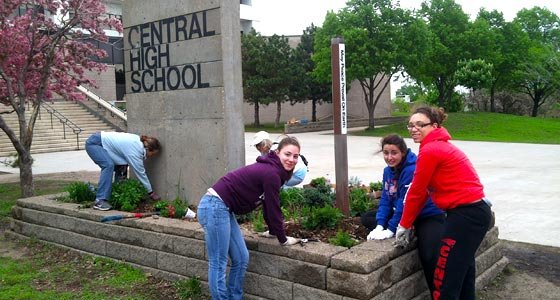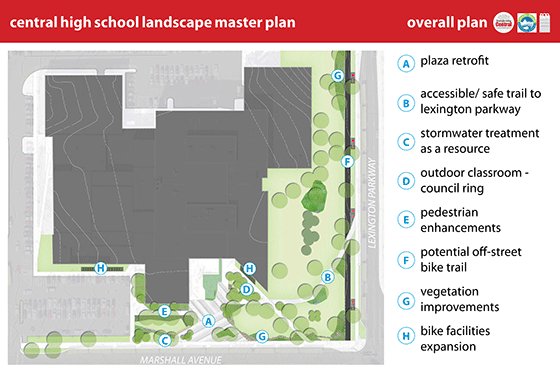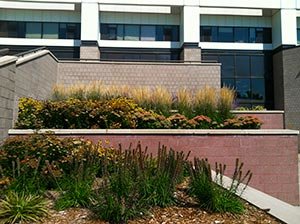“Transforming Central” receives multiple grants and assistance as it improves the environment  Students work on plantings to beautify Central as part of "Transforming Central."
Students work on plantings to beautify Central as part of "Transforming Central."[/caption]
By JAN WILLMS Big ideas sometimes start with small conversations. In 2011, the Parent Advisory Council at Central High School, 275 Lexington Pkwy., looked around at the grounds of the school and started talking about what might be done to make the school’s campus a more welcoming and environmentally healthy place. The “Transforming Central” project was born. “We looked at what hard shape things were in, such as packed earth, runoff and trees that needed to be trimmed,” said Julie Marckel, a member of the Council. “We started very simply, with bulb planting.” Central connected with Metro Design Center (MDC) at the University of Minnesota. This organization created a document with a list of projects.
 This is most recent plan development for Transforming Central as of press time; it may include slight changes as plans progress.
This is most recent plan development for Transforming Central as of press time; it may include slight changes as plans progress.[/caption]
“MDC does front-end conceptual planning for sites,” Marckel explained. “It looks at the before, and how it could be improved for the after. MDC looked at samples of planting on other similar campuses and did an analysis of the way students move, with heavy periods at the beginning and end of the day, and where students gather. This was done in 2011 and 2012.” In the summer of 2012, tiered beds of natives, perennials and grasses were planted in the front exterior stairway of the school. Marckel said a survey was conducted and facilitated by National Honor Society members. Students were asked what they liked best about Central, what made them the proudest, and what could be improved. Parents and teachers also provided feedback, and the Transforming Central project built on that information. In the fall of 2012, the Capitol Region Watershed District (CRWD) awarded the school a $10,000 grant in services to analyze storm water runoff. This resulted in a conceptual design for improving aesthetics and solving environmental issues.
 The tiered landscaping at Central High School presented some interesting and exciting platforms for the Transforming Central project.
The tiered landscaping at Central High School presented some interesting and exciting platforms for the Transforming Central project.[/caption] “CRWD worked with the architect firm of Emmons and Oliver and did a site analysis,” Marckel explained. “The Watershed District began to propose solutions around water runoff and rain gardens. It looked at worn dirt paths and storm water issues and improvements.” She said that with the assistance of Nate Zwonitzer, urban best management practices specialist with CRWD, Central received another $50,000 grant to help with a storm water retrofit project. This award will be used for design finalization to be provided to Central High School this year. “This past year we have continued to work with the Watershed District,” Marckel said. “It is focusing on water issues, but we also hope to address other things, such as the arts, sculpture and more landscaping.” She said the parents’ group supporting Transforming Central has developed a brochure and met with neighborhood community councils to share information about the project. Central was also selected as a site for the St. Paul Riverfront Corporation’s Placemaking Residency, and had Gil Penalosa, an internationally known placemaking expert who is passionate about designing cities for all people, speak to the students in May. A selected group of students joined him for a walk through the neighborhood and a follow-up talk to share what they had seen and discuss ways to connect to the community. “We’re now moving forward,” Marckel said. She said that information has been gathered about rain gardens and maintenance and the realities of snow removal. A goal for 2015-16 is to work on the front plaza areas. “This is such a large project, and we’re just a small band of parent volunteers,” Marckel commented. “Our challenge is to keep letting the students and faculty know that we are working on it.” She said Transforming Central is a three-pronged project, focusing on student experience, environmental impact and community connections. Studies have shown that student interaction with the natural elements on their campus can decrease stress and increase achievement levels. The Central site is also in a very vibrant neighborhood, according to Marckel. Zwonitzer said the Watershed District is trying to capitalize on Central’s efforts to improve the aesthetics of its exterior and also work on runoff solutions. “One of our big roles is to manage and treat storm water runoff,” he said. “The water at Central goes into a storm drain and is not treated at all, going into the river. We are trying to find ways to treat the water and get it to soak in the ground.” He said there are different ways of capturing storm water in underground storage systems, and the agency is trying to figure out which approach will work best. “There’s a big toolbox of ways to capture runoff,” he continued. “There are rain gardens and permeable pavers with gaps in between the pavers, so that the water soaks into the ground.” Zwonitzer said his agency has reached the stage where it is starting to incorporate ideas and plan. “There’s a lot in the mix,” he noted, “including our organization, the faculty, community, parents and the City of Saint Paul. It all takes time.” “What’s happening at Central is a good example of something we are trying to do district-wide,” added Tom Parent, interim director of facilities at St. Paul Public Schools (SPPS). “We’re at the beginning phase of a master plan for the district, and we have been part of that conversation at Central since its inception.” Parent said SPPS is looking at how schools’ grounds and community can be an extension of classrooms. “We want to be welcoming, inclusive and accessible to students from the moment they step off the bus,” Parent said.
 Students work on plantings to beautify Central as part of "Transforming Central."[/caption] By JAN WILLMS Big ideas sometimes start with small conversations. In 2011, the Parent Advisory Council at Central High School, 275 Lexington Pkwy., looked around at the grounds of the school and started talking about what might be done to make the school’s campus a more welcoming and environmentally healthy place. The “Transforming Central” project was born. “We looked at what hard shape things were in, such as packed earth, runoff and trees that needed to be trimmed,” said Julie Marckel, a member of the Council. “We started very simply, with bulb planting.” Central connected with Metro Design Center (MDC) at the University of Minnesota. This organization created a document with a list of projects.
Students work on plantings to beautify Central as part of "Transforming Central."[/caption] By JAN WILLMS Big ideas sometimes start with small conversations. In 2011, the Parent Advisory Council at Central High School, 275 Lexington Pkwy., looked around at the grounds of the school and started talking about what might be done to make the school’s campus a more welcoming and environmentally healthy place. The “Transforming Central” project was born. “We looked at what hard shape things were in, such as packed earth, runoff and trees that needed to be trimmed,” said Julie Marckel, a member of the Council. “We started very simply, with bulb planting.” Central connected with Metro Design Center (MDC) at the University of Minnesota. This organization created a document with a list of projects.  This is most recent plan development for Transforming Central as of press time; it may include slight changes as plans progress.[/caption] “MDC does front-end conceptual planning for sites,” Marckel explained. “It looks at the before, and how it could be improved for the after. MDC looked at samples of planting on other similar campuses and did an analysis of the way students move, with heavy periods at the beginning and end of the day, and where students gather. This was done in 2011 and 2012.” In the summer of 2012, tiered beds of natives, perennials and grasses were planted in the front exterior stairway of the school. Marckel said a survey was conducted and facilitated by National Honor Society members. Students were asked what they liked best about Central, what made them the proudest, and what could be improved. Parents and teachers also provided feedback, and the Transforming Central project built on that information. In the fall of 2012, the Capitol Region Watershed District (CRWD) awarded the school a $10,000 grant in services to analyze storm water runoff. This resulted in a conceptual design for improving aesthetics and solving environmental issues.
This is most recent plan development for Transforming Central as of press time; it may include slight changes as plans progress.[/caption] “MDC does front-end conceptual planning for sites,” Marckel explained. “It looks at the before, and how it could be improved for the after. MDC looked at samples of planting on other similar campuses and did an analysis of the way students move, with heavy periods at the beginning and end of the day, and where students gather. This was done in 2011 and 2012.” In the summer of 2012, tiered beds of natives, perennials and grasses were planted in the front exterior stairway of the school. Marckel said a survey was conducted and facilitated by National Honor Society members. Students were asked what they liked best about Central, what made them the proudest, and what could be improved. Parents and teachers also provided feedback, and the Transforming Central project built on that information. In the fall of 2012, the Capitol Region Watershed District (CRWD) awarded the school a $10,000 grant in services to analyze storm water runoff. This resulted in a conceptual design for improving aesthetics and solving environmental issues.  The tiered landscaping at Central High School presented some interesting and exciting platforms for the Transforming Central project.[/caption] “CRWD worked with the architect firm of Emmons and Oliver and did a site analysis,” Marckel explained. “The Watershed District began to propose solutions around water runoff and rain gardens. It looked at worn dirt paths and storm water issues and improvements.” She said that with the assistance of Nate Zwonitzer, urban best management practices specialist with CRWD, Central received another $50,000 grant to help with a storm water retrofit project. This award will be used for design finalization to be provided to Central High School this year. “This past year we have continued to work with the Watershed District,” Marckel said. “It is focusing on water issues, but we also hope to address other things, such as the arts, sculpture and more landscaping.” She said the parents’ group supporting Transforming Central has developed a brochure and met with neighborhood community councils to share information about the project. Central was also selected as a site for the St. Paul Riverfront Corporation’s Placemaking Residency, and had Gil Penalosa, an internationally known placemaking expert who is passionate about designing cities for all people, speak to the students in May. A selected group of students joined him for a walk through the neighborhood and a follow-up talk to share what they had seen and discuss ways to connect to the community. “We’re now moving forward,” Marckel said. She said that information has been gathered about rain gardens and maintenance and the realities of snow removal. A goal for 2015-16 is to work on the front plaza areas. “This is such a large project, and we’re just a small band of parent volunteers,” Marckel commented. “Our challenge is to keep letting the students and faculty know that we are working on it.” She said Transforming Central is a three-pronged project, focusing on student experience, environmental impact and community connections. Studies have shown that student interaction with the natural elements on their campus can decrease stress and increase achievement levels. The Central site is also in a very vibrant neighborhood, according to Marckel. Zwonitzer said the Watershed District is trying to capitalize on Central’s efforts to improve the aesthetics of its exterior and also work on runoff solutions. “One of our big roles is to manage and treat storm water runoff,” he said. “The water at Central goes into a storm drain and is not treated at all, going into the river. We are trying to find ways to treat the water and get it to soak in the ground.” He said there are different ways of capturing storm water in underground storage systems, and the agency is trying to figure out which approach will work best. “There’s a big toolbox of ways to capture runoff,” he continued. “There are rain gardens and permeable pavers with gaps in between the pavers, so that the water soaks into the ground.” Zwonitzer said his agency has reached the stage where it is starting to incorporate ideas and plan. “There’s a lot in the mix,” he noted, “including our organization, the faculty, community, parents and the City of Saint Paul. It all takes time.” “What’s happening at Central is a good example of something we are trying to do district-wide,” added Tom Parent, interim director of facilities at St. Paul Public Schools (SPPS). “We’re at the beginning phase of a master plan for the district, and we have been part of that conversation at Central since its inception.” Parent said SPPS is looking at how schools’ grounds and community can be an extension of classrooms. “We want to be welcoming, inclusive and accessible to students from the moment they step off the bus,” Parent said.
The tiered landscaping at Central High School presented some interesting and exciting platforms for the Transforming Central project.[/caption] “CRWD worked with the architect firm of Emmons and Oliver and did a site analysis,” Marckel explained. “The Watershed District began to propose solutions around water runoff and rain gardens. It looked at worn dirt paths and storm water issues and improvements.” She said that with the assistance of Nate Zwonitzer, urban best management practices specialist with CRWD, Central received another $50,000 grant to help with a storm water retrofit project. This award will be used for design finalization to be provided to Central High School this year. “This past year we have continued to work with the Watershed District,” Marckel said. “It is focusing on water issues, but we also hope to address other things, such as the arts, sculpture and more landscaping.” She said the parents’ group supporting Transforming Central has developed a brochure and met with neighborhood community councils to share information about the project. Central was also selected as a site for the St. Paul Riverfront Corporation’s Placemaking Residency, and had Gil Penalosa, an internationally known placemaking expert who is passionate about designing cities for all people, speak to the students in May. A selected group of students joined him for a walk through the neighborhood and a follow-up talk to share what they had seen and discuss ways to connect to the community. “We’re now moving forward,” Marckel said. She said that information has been gathered about rain gardens and maintenance and the realities of snow removal. A goal for 2015-16 is to work on the front plaza areas. “This is such a large project, and we’re just a small band of parent volunteers,” Marckel commented. “Our challenge is to keep letting the students and faculty know that we are working on it.” She said Transforming Central is a three-pronged project, focusing on student experience, environmental impact and community connections. Studies have shown that student interaction with the natural elements on their campus can decrease stress and increase achievement levels. The Central site is also in a very vibrant neighborhood, according to Marckel. Zwonitzer said the Watershed District is trying to capitalize on Central’s efforts to improve the aesthetics of its exterior and also work on runoff solutions. “One of our big roles is to manage and treat storm water runoff,” he said. “The water at Central goes into a storm drain and is not treated at all, going into the river. We are trying to find ways to treat the water and get it to soak in the ground.” He said there are different ways of capturing storm water in underground storage systems, and the agency is trying to figure out which approach will work best. “There’s a big toolbox of ways to capture runoff,” he continued. “There are rain gardens and permeable pavers with gaps in between the pavers, so that the water soaks into the ground.” Zwonitzer said his agency has reached the stage where it is starting to incorporate ideas and plan. “There’s a lot in the mix,” he noted, “including our organization, the faculty, community, parents and the City of Saint Paul. It all takes time.” “What’s happening at Central is a good example of something we are trying to do district-wide,” added Tom Parent, interim director of facilities at St. Paul Public Schools (SPPS). “We’re at the beginning phase of a master plan for the district, and we have been part of that conversation at Central since its inception.” Parent said SPPS is looking at how schools’ grounds and community can be an extension of classrooms. “We want to be welcoming, inclusive and accessible to students from the moment they step off the bus,” Parent said.
Comments
No comments on this item Please log in to comment by clicking here